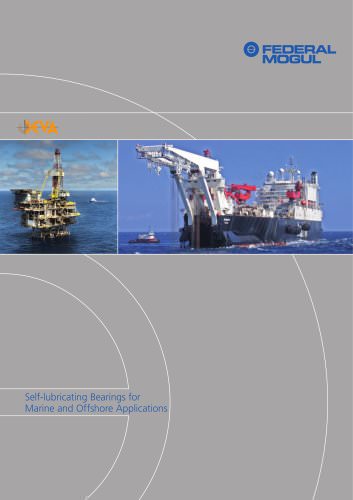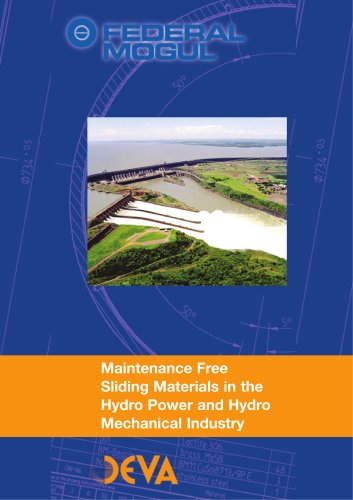 Website:
Federal-Mogul Deva GmbH
Website:
Federal-Mogul Deva GmbH
Group: Tenneco Group
Catalog excerpts
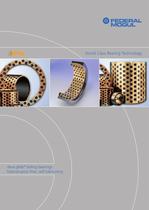
World Class Bearing Technology deva.glide® sliding bearings Maintenance-free, self-lubricating
Open the catalog to page 1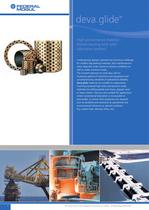
deva.glide ® High performance material – Bronze bearing with solid lubrication pockets Contemporary designs represent an enormous challenge for modern-day bearing materials. Zero maintenance is often expected under severe to extreme conditions as well as under maximum loads. The constant pressure on costs also calls for increasing uptime of machinery and equipment and uncompromising standards of operational reliability. deva.glide materials are suitable for applications involving sustained high static and dynamic loads, relatively low sliding speeds and rotary, angular, axial or linear...
Open the catalog to page 2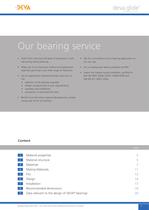
Profit from more than 60 years of experience in self- lubricating sliding bearings. Make use of our extensive material and application expertise spanning a very wide range of industries. Let our application engineering team assist you in ■ selection of the bearing materials, ■ design, purpose-built to your requirements, ■ calculation of estimated life time. Benefit from the latest material developments, tested using state of the art facilities. Ask for a simulation of your bearing application on Let us analyse your bearing problem by FEM. Expect the highest quality standards, certified to...
Open the catalog to page 3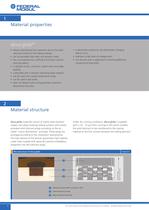
1 Material properties deva.glide® is electrically conductive. No electrostatic charging effects occur. tolerates a high level of misalignment. can also be used in applications involving additional, conventional lubrication. allows maintenance-free operation due to the solid lubricant content of the sliding material. can accomodate high static and dynamic loads. has a consistently low coefficient of friction without stick-slip effects. is resistant to dirt, corrosion, impact stress and edge loading. is provided with a vibration absorbing base material. can be used over a large temperature...
Open the catalog to page 4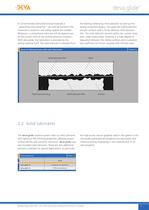
deva.glide ® maintenance-free In conventionally lubricated bronze materials a „separating lubricating film“ can only be formed if the movement conditions and sliding speeds are suitable. Moreover, a conventional lubricant will be sqeezed out of the contact zone as the surface pressure increases. With deva.glide, the lubrication is provided by the sliding material itself. The solid lubricant is released from the bearing material by micro abrasion as soon as the sliding movement begins. This gives the sliding partners smooth surfaces with a firmly adhesive solid lubricant film. The solid...
Open the catalog to page 5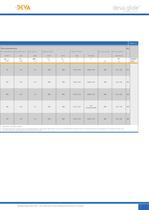
deva.glide ® maintenance-free Table 3.1.1 Bearing properties Max. permissible load [static] 3) dg Max. sliding velocity [dry] Max. – value pU [dry] Temperature range Coeficient of friction 4) Min. shaft hardness [max] [min] [dry] [in water] Tmax Tmin f f m/s °C °C 0.4 1.0 250 -100 0.10 - 0.12 110 0.4 1.0 250 -100 150 0.4 1.5 250 150 0.4 1.5 110 0.4 1.0 _ pstat/max U max _ pU max MPa MPa 75 Shaft surface finish [optimum] Ra Symbol HB µm Unit 0.08 - 0.12 180 0.2 - 0.8 01 0.10 - 0.12 0.08 - 0.12 180 0.2 - 0.8 02 -100 0.10 - 0.13 0.08 - 0.12 300 0.2 - 0.8 03 250 -100 0.12 - 0.15 not recommended...
Open the catalog to page 7
3.2 Chemical resistance The following decision chart provides guidance on the selection of the appropriate deva.glide® alloy according to the environmental conditions of the application. Definitions Resistant Resistant depending on construction, oxygen content, temperature, etc. Not recommended – No data available Chemical resistance of deva.glide Medium / chemical substance Concentration in % Table 3.2.1 Temperature in °C Alloys deva.glide dg01 dg02 dg03 dg04 dg05 Strong acids Hydrochloric acid 5 20 Hydroflouric acid 5 20 Nitric acid 5 20 Sulphuric acid 5 20 Phosphoric acid 5 20 Acetic...
Open the catalog to page 8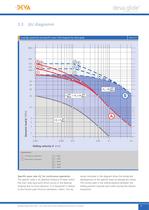
deva.glide ® maintenance-free 3.3 _ pU diagramm _ Load (p), speed (U) and specific wear (∆Sh) diagram for deva.glide Figure 3.3.1 400 200 150 3 4 3 120 2 5 2 5 1 1 100 4 50 40 ∆Sh > 25 30 5 20 µm Rkm B µm µm ≤ ∆Sh ≤ 25 Rkm Rkm _ Dynamic load p [MPa] 10 5 ∆Sh ≤ 5 4 A µm Rkm 3 2 0.001 0.005 0.01 0.05 0.1 0.4 Sliding velocity U [m/s] Explanation: A Continuous operation 1 = dg01 B Intermittent operation 2 = dg02 3 = dg03 4 = dg04 5 = dg05 Specic wear rate ∆Sh for continuous operation The specific wear is an absolute measure of wear within the main load zone [µm] which occurs in the bearing...
Open the catalog to page 9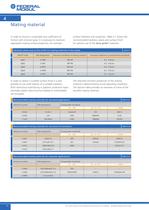
4 Mating material surface hardness and roughness. Table 4.1 shows the recommended hardness values and surface finish for optimal use of the deva.glide® materials. In order to ensure a sustainable low coefficient of friction with minimal wear, it is necessary to maintain appropiate mating surface properties, for example Hardness values and surface finish for mating materials of deva.glide Table 4.1 DEVA® Code DIN designation Minimum hardness of mating material Average roughness Ra (produced by grinding) dg01 2.1090 180 HB 0.2 - 0.8 µm dg02 2.1061 180 HB 0.2 - 0.8 µm dg03 2.0975 300 HB 0.2 -...
Open the catalog to page 10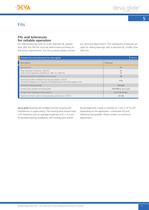
deva.glide ® maintenance-free 5 Fits Fits and tolerances for reliable operation For sliding bearings with an outer diameter D1 greater than 300 mm the fits must be determined according to the actual requirements. For this purpose please contact our technical department. The subsequent proposals are valid for sliding bearings with a diameter D1 smaller than 300 mm. Reliable fits and tolerances for deva.glide Table 5.1 Description Tolerance Housing bore H7 Outer diameter of bearing < 200 mm under normal operating conditions (t ≈ 80° C) ≥ 200 mm s6 r6 Bearing bore prior to installation into...
Open the catalog to page 11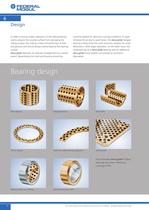
6 Design In order to ensure proper operation of the sliding bearing and to prevent the counter surface from damaging the sliding surface, the mating surface should be free of ats and grooves and should always extend beyond the bearing surface. deva.glide bearings can tolerate misalignment to a certain extent. Nevertheless the shaft and housing should be correctly aligned for optimum running conditions. In cases of lateral thrust due to axial forces, the deva.glide anged bearing is likely to be the most economic solution for small dimensions. With larger diameters, on the other hand, the...
Open the catalog to page 12All Federal-Mogul Deva GmbH catalogs and technical brochures
-
deva_metal_EN
21 Pages
-
deva_glide_EN
17 Pages
-
deva_tex_EN
32 Pages
-
deva_bm_EN
32 Pages
Archived catalogs
-
DEVA Spherical Bearings
32 Pages
-
deva.metal technical handbook
24 Pages
-
deva.bm technical handbook
24 Pages
-
deva.tex technical Handbbok
20 Pages
-
Product Range
12 Pages










